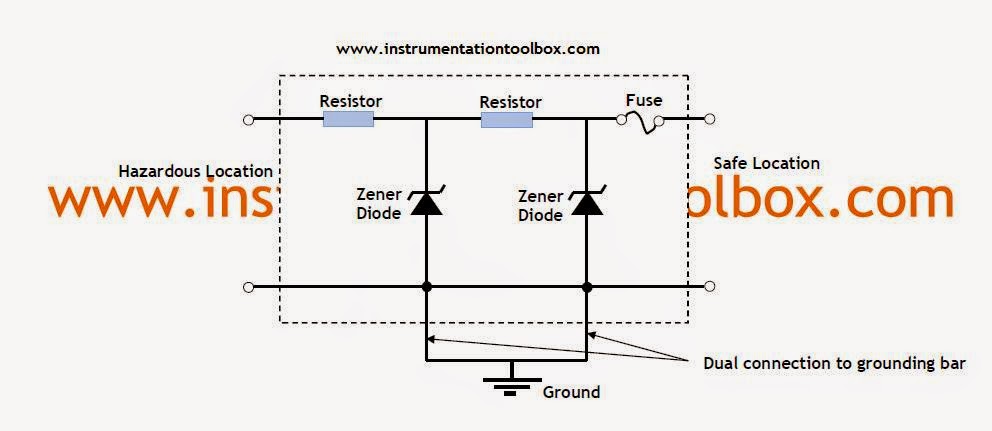
Custom Search
Intrinsic safety (IS) is a method of providing safe operation of electronic process‐control instrumentation in hazardous areas. IS systems keep the available electrical energy in the system low enough that ignition of the hazardous atmosphere cannot occur. No single field device or wiring is intrinsically safe by itself (except for battery‐operated, self‐contained devices), but is intrinsically safe only when employed in a properly designed IS system. The concept of intrinsic safety recognizes that an energy discharge limit exists below which ignition cannot be brought about. The concept also recognizes the possibility of failure within the electrical equipment and requires that safety not be impaired by the occurrence of faults within the equipment or protective mechanism. The concept of intrinsic safety is shown below:
 |
| Concept of Intrinsic Safety |
As shown above, most applications require a signal to be sent out of or into the hazardous area. The equipment
mounted in the hazardous area must first be approved for use in an intrinsically safe system. The barriers designed to protect the system must be mounted outside of the hazardous area (as shown above) in an area designated as Non-hazardous or safe in which the hazard is not and will not be present.
mounted in the hazardous area must first be approved for use in an intrinsically safe system. The barriers designed to protect the system must be mounted outside of the hazardous area (as shown above) in an area designated as Non-hazardous or safe in which the hazard is not and will not be present.
Equipment requiring Safety Barriers:
Some common equipment that has been designed for and is available for use in hazardous areas with intrinsically safe barriers includes:
- 4-20 mA dc Two Wire Transmitters
- Thermocouples
- RTDs
- Strain Gages
- Pressure, Flow, & Level Switches
- I/P Converters
- Solenoid Valves
- Proximity Switches
- Infrared Temperature Sensors
- Potentiometers
- LED Indicating Lights
- Magnetic Pickup Flowmeters
Most of the equipment/devices mounted in the Hazardous area will have to be approved and certified for use in the Hazardous area with an approved barrier designed for use with that device. Also note that all intrinsic safety equipment usually undergo rigorous testing and approval by an independent agency to assure its safety.
Intrinsic Safety Barriers
An intrinsic safety (IS) barrier is a safety device that helps to limit energy flow into a hazardous location. IS barriers are often used with traditional two‐wire 4‐20 mA instruments to ensure an intrinsically safe system in hazardous areas. With traditional analog instrumentation, energy to the field can be limited with or without a ground connection by installing one of the following safety barriers:
(a) Shunt‐diode (zener) barriers that use a high‐quality safety ground connection to bypass excess energy as shown below:
 |
| Shunt Diode Zener Barrier |
(b) Isolators that do not require a ground connection; they repeat the analog measurement signal across an isolated interface in the non-hazardous‐side load circuit as shown below:
 |
| Isolator Safety Barrier |
Zener Safety Barriers
Zener diode safety barriers are very popular in intrinsic safety applications.
This type of barrier can be positive, negative or AC type and conducts the excess energy to ground. They may also be single, dual or multiple-circuit construction. Zener diodes safety barriers typically contain resistors to limit current through barrier to a safe value; zener diodes or triacs and zener diodes to limit the voltage that may appear at the terminals in the hazardous area to acceptable value. At least two of each of these components – diodes, resistors or triacs – are used in such a way that the failure of one does not render the arrangement unsafe. A fuse is also used to open the circuit when excessive current threatens the circuit. All the components in a safety barrier are encapsulated to prevent tampering and the failure of any component particularly the fuse renders the device useless and in need of replacement. No repairs to a barrier may be made. However, some recent types now support replaceable fuses. The circuit of a typical single circuit zener diode safety barrier is shown below:
 |
| Schematic of a Zener diode based Safety Barrier |
As seen above, the barrier is grounded by a dual connection that carries any excess or fault currents to ground thus preventing its entry into the hazardous location.